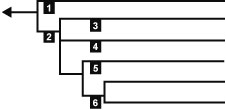| NIES-MCC | KU-MACC | Tree to Strain | Japanese | English |
| Life / Eukarya / Opisthokonta / Fungi / Chytridiomycota / Monoblepharidomycetes | |

|
Hyaloraphidium Oedogoniomyces Harpochytrium Gonapodya Monoblepharella Monoblepharis |
|
1. Hyaloraphidiales, Hyaloraphidiaceae 2. Monoblepharidales 2. Oedogoniomycetaceae 3. Harpochytriaceae 4. Gonapodyaceae 5. Monoblepharidaceae |
|
| Reference |
|
|
The monoblepharidomycetes are zoosporic fungi living in freshwater. The early divergences such as Hyaloraphidium (previously classified as colorless green alga) grow as simple monocentric unbranched thalli but Gonapodya, Monoblepharella and Monoblepharis form polycentric coenocytic mycelia. Flagellate cell containes a basal body parallel to a non-flagellated centriole. The elecron opaque core is usually present in the transitional region of flagellum. Microtubules radiating anteriorly from the striated disk partially extending around the basal body in flagellate cell. Zoospore possesses a ribosomal aggregation and rumposome (fenestrated cisterna) adjacent to a microbody. Asexual reproduction by zoospores or autospores. Sexual reproductions in polycentric species are oogamous by means of uniflagellate antherozoids borne in antheridia and nonflagellate female gametes borne in oogonia. |